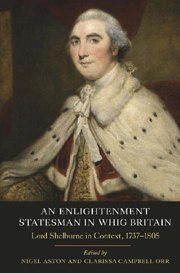Book contents
- Frontmatter
- Contents
- List of Illustrations
- List of Contributors
- Acknowledgements
- List of Abbreviations
- Introduction
- Part One Family, Piety, and Finance
- 1 Petty and Fitzmaurice: Lord Shelburne and his Brother
- 2 Aunts, Wives, Courtiers: The Ladies of Bowood
- 3 A Christian Whig: Lord Shelburne and the Latitudinarian Tradition
- 4 Lord Shelburne, Finance, and Sir Francis Baring
- Part Two Politics
- Part Three The Bowood Circle Revisited
- Index
- STUDIES IN EARLY MODERN CULTURAL, POLITICAL AND SOCIAL HISTORY
1 - Petty and Fitzmaurice: Lord Shelburne and his Brother
from Part One - Family, Piety, and Finance
Published online by Cambridge University Press: 05 September 2013
- Frontmatter
- Contents
- List of Illustrations
- List of Contributors
- Acknowledgements
- List of Abbreviations
- Introduction
- Part One Family, Piety, and Finance
- 1 Petty and Fitzmaurice: Lord Shelburne and his Brother
- 2 Aunts, Wives, Courtiers: The Ladies of Bowood
- 3 A Christian Whig: Lord Shelburne and the Latitudinarian Tradition
- 4 Lord Shelburne, Finance, and Sir Francis Baring
- Part Two Politics
- Part Three The Bowood Circle Revisited
- Index
- STUDIES IN EARLY MODERN CULTURAL, POLITICAL AND SOCIAL HISTORY
Summary
Prologue: Two Legacies
The focus in this chapter is primarily on the turbulent and unsatisfying relationship that persisted between Lord Shelburne and his younger brother, the Hon. Thomas Fitzmaurice (1742–93). They illustrate parallel paths in integrating themselves as an ancient Anglo-Irish family, more Irish than English and primarily resident in Ireland, into the British political and cultural establishment, with seats respectively in both British Houses of Parliament. Their dealings towards each other were characterized by a caution and often a distance that had its origins in early life and is symbolized by their different surnames: respectively, Petty and Fitzmaurice. For Thomas was no ordinary younger son: he was made the heir to many of the Fitzmaurice properties in Ireland which came to him in 1761 and 1780, whereas his brother, the 2nd Earl, acquired principally the Petty settled estates from his father. Shelburne's relations with his closest male family members were often awkward and strained and one might say that the multiple misunderstandings between the siblings nicely parallel the 2nd Earl's habitually awkward dealings with other members of the late eighteenth-century British political elite. Though Thomas in life had an equivalent share of disappointments and frustrations to Shelburne's, he was a pioneering gentleman industrialist and his career and character desperately need rescuing from the shadow of his elder brother's. This chapter is an initial attempt at recovery.
The seeds of fraternal disgruntlement were sown while William (the future 2nd Earl) (Figure 1) and Thomas (Figure 2) were boys being brought up in Ireland during the 1740s.
- Type
- Chapter
- Information
- An Enlightenment Statesman in Whig BritainLord Shelburne in Context, 1737–1805, pp. 29 - 50Publisher: Boydell & BrewerPrint publication year: 2011

